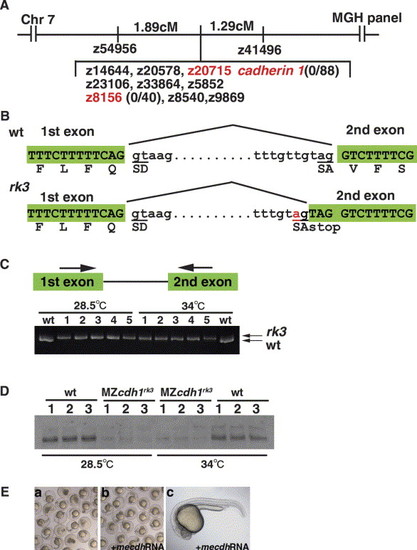Fig. 3
- ID
- ZDB-FIG-070821-16
- Publication
- Shimizu et al., 2005 - E-cadherin is required for gastrulation cell movements in zebrafish
- Other Figures
- All Figure Page
- Back to All Figure Page
|
The rk3 locus encodes E-cadherin. (A) The rk3 locus was mapped to chromosome 7 close to the SSLP marker z8156 (no recombination in 40 meioses). The e-cadherin (cdh1) gene is located near z20715 in the radiation hybrid T51 panel, which was mapped adjacently with z8156 in the MGH panel. We found no recombination of a RFLP marker within the cdh1 gene in 88 meiotic events. (B) The rk3 allele contains a mutation in the first intron of the cdh1 gene. The mutation introduces an aberrant splicing acceptor and a premature stop codon on the 52 side of the codon of Val-71. (C) The rk3 locus generates an abnormal splicing variant. The rk3 zygotic homozygous embryos were cultured at 28.5 or 34 °C. RNAs from mutant embryos that survived more than 24 hpf were isolated and subjected to RT-PCR using primers that correspond to the 32 end of the first exon and the 52 end of the second exon. The PCR products were separated in a 20% polyacrylamide gel. The PCR product in each lane was derived from a single embryo. The mutant embryos had a longer transcript irrespective of the culture temperature. (D) E-cadherin protein was severely decreased in the maternal-zygotic (MZ) cdh1rk3 mutants. Embryos obtained from crossing the homozygous cdh1rk3 mutants, which were rescued by the expression of mouse e-cadherin, were grown at 28.5 or 34 °C, until wild-type (wt) embryos born at the same time reached the five-to-six somite stage. The embryo lysates were separated by SDS-PAGE and immunoblotted with anti-zebrafish E-cadherin antibodies. (E) Injection of 400 pg mouse e-cadherin (mcdh1) RNA suppressed the phenotypes of the zygotic rk3 mutant phenotypes (Eb, c). Ea, control. |
Reprinted from Mechanisms of Development, 122(6), Shimizu, T., Yabe, T., Muraoka, O., Yonemura, S., Aramaki, S., Hatta, K., Bae, Y.K., Nojima, H., and Hibi, M., E-cadherin is required for gastrulation cell movements in zebrafish, 747-763, Copyright (2005) with permission from Elsevier. Full text @ Mech. Dev.

